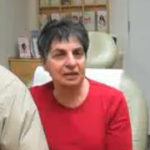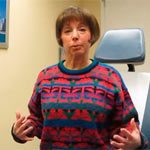Although the name of our practice New Horizons Center for Cosmetic Surgery suggests that our physicians specialize only in cosmetic surgery, Dr Turowski is fully- trained plastic surgeons who are committed to providing the most advanced and comprehensive breast reconstruction after mastectomy or lumpectomy.
We understand that the diagnosis of breast cancer often presents an emotional and physical strain on you and your family, and we want you to know that we will work in concert with your team of physicians to provide the highest quality of care available in a compassionate manner. You can be assured that our priorities are aligned with you and your cancer doctors, with the top priority to cure your cancer.
Although you may have already been referred to, or have seen another plastic surgeon for a consultation regarding breast reconstruction, you should consider a second opinion from a plastic surgeon specializing in this type of surgery. The decision-making process and overall surgical experience that is vital for the success of these highly complex surgeries are of upmost importance. Therefore, it is important to become fully informed and make an educated decision:
- When considering your choices in breast reconstruction, you should weigh the pros and cons of having surgery performed at a large teaching institution, where you may be operated on by a surgeon-in-training under the supervision of an attending surgeon. This is in contrast to a private hospital, where all your surgery and care will be performed personally by very experienced attending surgeons.
- Smaller institutions that specialize in breast cancer treatment usually offer a more personalized approach to care and yet have the same high standards offered by its larger counterparts.
- At a consultation, you should be able to view multiple postoperative photographs of actual patients, who have undergone similar procedures in all stages of the reconstructive process.
- If desired, you should be able to contact previous patients who have underwent similar procedures to hear real stories of their recovery and healing process.
The goal of reconstructive surgery is to restore what has been removed by various approaches based on your preferences and appropriateness of the surgery. During your consultation, we will discuss in detail the available options for breast reconstruction, taking into consideration your medical history, need for adjunctive treatments such as chemotherapy and radiation, and personal preferences. Based on this information, we tailor a plan and coordinate surgery with your breast surgeon. If you do not have a breast surgeon, we will be able to refer you to several surgeons specializing in breast cancer surgery. This is of paramount importance, since the final results of an immediate breast reconstruction depend greatly on the teamwork of the breast cancer surgeon and plastic surgeon. It is our goal to provide you with as much information as possible to assist in making an informed decision about breast reconstruction.
Many decisions need to be made to decide which reconstructive option is most appropriate for you. Most breast reconstruction can be performed at the time of the mastectomy, or in other words – immediate breast reconstruction. However, there are rare circumstances where a delayed breast reconstruction may be recommended, depending on if you will require other treatments after the mastectomy. If the reconstructive surgery was not performed during the initial mastectomy surgery, depending on circumstances, delayed breast reconstruction can usually be performed as soon as several weeks after the original surgery. We have also performed breast reconstructions as late as 30 years after the initial mastectomy. Barring any coexisting major medical problems, the age of the patient is usually not a limiting factor.
The reconstructive options available differ in their approach, amount of time for the initial surgery, length of hospitalization and recovery time, and need for future procedures. In general, breast reconstruction, from creation of a breast mound to nipple and areola reconstruction, requires staged procedures, although the subsequent procedures usually are minor outpatient or in-office surgeries with significantly shorter recovery times. To provide our patients an exceptional experience and for their convenience, most of these secondary procedures can be performed in our private fully- accredited state-of-the-art surgery center.
Breast reconstruction options
Broadly speaking, breast reconstruction can be divided into implant-based reconstruction or autologous (your own tissue) reconstruction. However, there are reconstructions, such as the latissimus dorsi flap from your back, that incorporates both your own tissue with an implant to create a breast of appropriate volume based on your preferences or to match the other remaining breast.
Breast reconstruction – FAQ
Who is a candidate?
Any woman who is going to have or has had a unilateral or bilateral mastectomy is a candidate for breast reconstruction. Occasionally, breast reconstruction is also necessary to correct post-lumpectomy changes in breast shape or size.
Should my reconstruction be immediate or delayed?
In most situations an immediate breast reconstruction (done at the time of the mastectomy) is appropriate. The advantage of this approach is that you wake up from the surgery with a new breast, or the beginnings of a new breast, already in place. In addition, when the breast reconstruction is performed immediately, the soft tissue envelope is not allowed to heal and contract, which often enhances the eventual reconstructive result. There are some instances where Dr Turowski will recommend a delayed reconstruction, but this decision is made on an individualized basis.
Where are the scars after breast reconstruction?
This depends on the type of reconstruction performed. With a tissue expander/implant based reconstruction, the scar created from the mastectomy provides access for the breast reconstruction. With a latissimus dorsi flap reconstruction, there is an additional scar on your back. With a TRAM flap reconstruction, there is an additional scar on your lower abdomen, analogous to that created during an abdominoplasty or “tummy tuck”.
Will the reconstructed breast be symmetric to the existing breast?
In cases of unilateral reconstruction, every attempt is made to create a balanced, natural appearing reconstructed breast. This may require staged surgeries. In addition, Dr Turowski may recommend a surgery on the contralateral breast (such as a breast augmentation, reduction, or lift) to make matching the reconstructed breast easier or making overall improvement in your appearance. In cases of bilateral reconstruction, symmetry is often obtained because the same reconstructive technique is applied to both breasts.
Will the reconstructed breast have sensation?
A reconstructed breast usually does not have normal sensation that existed before the surgery, but most women find that some sensation returns after several months.
What is the recovery after breast reconstruction?
This depends on the type of reconstruction. After a tissue expander/implant reconstruction, you can expect the stay in the hospital for 24-48 hours. For a latissimus dorsi flap reconstruction, hospitalization ranges from 2-3 days. After a TRAM flap, you can expect a 3-5 day hospital stay.
Pain medications are typically required for 1-2 weeks, and activity is gradually increased over a several week period of time. Occasionally, we recommend physical therapy after breast reconstruction to regain mobility and strength.
What is done for restoring the nipple and areola?
The final stage of breast restoration takes place after the breast mound is created. Initially the nipple is reconstructed using local tissue, and then medical tattooing is performed to restore the color of the areola. Both of these are performed as minor office procedures.
Can breast cancer recur after breast reconstruction?
In rare instances, breast cancer can recur after a lumpectomy or mastectomy with or without reconstruction. Modern techniques, such as mammogram, ultrasound, and MRI, allow detection of breast cancer recurrences even in the setting of a reconstructed breast. Your team of physicians will monitor you for recurrences with the appropriate tests after your mastectomy and reconstruction. Several studies showed no difference in recurrence detection or patient survivals in patient with or without reconstructions..
Does insurance cover breast reconstruction?
Insurance companies and managed care organizations are now required to pay for breast reconstruction for women who have had a mastectomy. Health care plans are also required to pay for surgery to make the opposite natural breast match the reconstructed breast. The Women’s Health and Cancer Rights Act of 1997, which ensures these rights, states that:
“A group health plan, and a health insurance issuer providing health insurance coverage in connection with a group health plan, that provides medical and surgical benefits with respect to a mastectomy shall ensure that, in a case in which a mastectomy patient elects breast reconstruction, coverage is provided for:
- All stages of reconstruction of the breast on which the mastectomy has been performed; and
- Surgery and reconstruction of the other breast to produce a symmetrical appearance;
in the manner determined by the attending physician and the patient to be appropriate, and consistent with any fee schedule contained in the plan.”
This law is also observed by Medicare and Medicaid. However, you should still check with your insurance company ahead of time – most companies require that you obtain authorization in advance about any surgery that is not an emergency. Also, not all insurance companies cover nipple tattooing, so ask about this procedure if you think you would like to have it done. If you do not have insurance, you should talk with your doctor about the cost of the breast reconstruction surgery and office visits.
Implant-based reconstruction
A breast implant is a round or teardrop-shaped shell, filled with saline (salt-water) or silicone gel. The implant is placed behind the pectoralis major chest muscle in a manner similar to what occurs during breast augmentation surgery.
In a select group of women, implants may be placed as a one-stage process, where a permanent implant is used at the time of the mastectomy. However, most women require a two-stage process, using a tissue expander before the permanent implant is placed.
A tissue expander is an implant with a valve/port that can be filled with saline to stretch the remaining chest skin and soft tissues to make room for the breast implant. The tissue expander is placed under the pectoralis major muscle at the time of your mastectomy. After the incisions have healed, a small valve/port is accessed and saline is injected into the expander during several office visits, usually over a 6-8 week period of time. This gradual stretching creates more skin and soft tissue, not unlike how the skin of the abdomen stretches during a pregnancy. The tissue expander is filled until it is slightly larger than the desired size to assure that the skin and soft tissue can accommodate the permanent implant. At a second surgery, the tissue expander is replaced with a permanent saline or silicone implant.
The advantage of this type of reconstruction is that the initial surgery is shorter, on average adding only 1-2 hours to the mastectomy surgery and typically requiring only a single day of hospitalization. Since this technique does not involve removal of tissue from another site of your body, it does not create any additional scars or potential donor-site morbidity (see below for more details).
The disadvantage of this approach is that it typically involves a tissue expander, which requires at least 2 surgical stages and multiple visits to our office during the expansion process. There are instances where this may be more challenging for the patient than a recovery from a latissimus dorsi flap reconstruction (see below). In addition, an implant does not have the same shape and feel of a natural breast, so that it may make matching the opposite breast more difficult (for patients only having a unilateral or one-sided mastectomy). As opposed to other types of reconstruction this type of surgery may produce a higher risk of early complications when performed as immediate breast reconstruction. In the short-term, the implant can become infected or malpositioned, which may require surgery to correct these problems. In the longer-term, implants may eventually require subsequent procedures to replace them due to capsular contracture, rupture, or malposition.
Autologous tissue reconstructions
Breast reconstruction can be performed without implants, using a flap of your own tissue. A flap entails a combination of skin, fat, and/or muscle that is taken from one portion of your body and moved to your chest to create a breast. The advantages of using your own tissues are that it typically has a more natural shape and feel of a native breast, and that it typically avoids the use of an implant. It also offers immediate reconstruction of the breast shape that usually requires only minor adjustments during secondary procedures. The disadvantages of this approach are that it requires a longer surgery and recovery time, and creates an additional scar on your body, with the potential for donor-site morbidity. The main autologous reconstructions use tissues from the back or abdomen and are described below.
Latissimus Dorsi Flap
A latissimus dorsi flap involves taking the skin, fat, and latissimus dorsi muscle from your back (in the area below your scapula or shoulder blade) and tunneling it through the axilla or armpit to create a breast. Sometimes it is possible to use this flap without implants in order to achieve the desired size. However, this technique often is used in conjunction with a tissue expander or implant to reconstruct the breast.
Why use a latissimus flap if you are going to use an implant anyway? There are several reasons. Using a latissimus flap with an implant typically has a more natural shape and feel than an implant alone. One way to describe this effect is for you to imagine putting an implant under a bed sheet. With only a thin sheet over the implant, all of the contours of the implant are visible and the implant can be readily felt. On the other hand, if the implant is placed under a thick comforter, the implant is there only to provide volume, and is not as visible or palpable. The former analogy describes an implant-only based reconstruction, while the latter analogy describes the latissimus flap with implant reconstruction. In addition, placing the skin, fat, and muscle over an implant may reduce complications relating to infection and radiation therapy.
Therefore, the advantages of the latissimus flap are that it decreases some of the risks of using an implant, it typically is easier to match the opposite breast with this approach, and it replaces deficient skin and soft tissue which may be missing or damaged after the mastectomy and/or radiation treatments. In cases of immediate breast reconstruction, the patient emerges from the mastectomy and reconstructive surgery almost completely restored to a natural (or sometimes better) size and shape as compared to having a mound of tissue present if an expander is utilized. After the initial surgery, there often is no additional expansion necessary. Therefore the recovery period is usually surprisingly easier than for an expander/implant reconstruction, because there is no need for the sometimes-painful injections and stretching associated with the expansion process. We utilize this technique in all age groups (young and old) with tremendous success. We believe it is optimal for women looking for a relatively quick recovery and very satisfactory results without the disadvantages of prolonged expansion and problems of implant exposure.
The disadvantages of this approach are that it requires a longer surgery, and it results in an additional scar on your back where the flap is obtained (although this scar is usually well hidden by your bra). The loss of muscle function is usually well compensated by the other muscles of the shoulder and back.
TRAM Flap
The TRAM flap stands for a Transverse Rectus Abdominus Myocutaneous Flap. Put simply, it uses your abdominal skin and fat based on blood vessels that travel through the rectus abdominus muscle (sometimes known as your six-pack muscle). There are many variations of this type of flap which indicates the method by which Dr Turowski move the abdominal tissue up to the chest to create the breast. In a peddled TRAM, the tissue is moved to the chest by a subcutaneous tunnel in the lower portion of your breast. In a free TRAM, the abdominal tissue is transferred to the chest by using microsurgical techniques to reconnect the blood vessels that provide nourishment to the tissues.
The advantages of the TRAM are that it removes abdominal tissue to reconstruct the breast, which improves your abdominal contour after surgery (similar to an abdominoplasty or tummy tuck). In addition, it avoids the use of an implant, has a more natural look and feel, and is durable.
The disadvantages of this approach are that it requires a longer surgery with a longer recovery time than for both an implant-based or latissimus flap reconstruction, it creates a scar across your lower abdomen (similar to the scar after a tummy tuck), it may result in some abdominal muscle weakness, and it is possible to develop bulging or a hernia at the site where the flap is taken from.
DIEP and SIEA Flap
The DIEP and SIEA flaps stand for the Deep Inferior Epigastric Perforator and Superficial Inferior Epigastic Artery flaps, respectively. These flaps fall under the category of perforator flaps, which are advanced microsurgical procedures that attempt to spare the abdominal muscles. The advantage of using these flaps is that it spares the abdominal wall fascia and muscles, and may reduce the incidence of weakness, hernia/bulging, and post-operative pain. The disadvantages of the DIEP and SIEA flaps are that is a significantly longer operative procedure, and has the risk of problems with the microsurgical connections of the blood vessels.
Surgery on the other breast
In some patients who are receiving a unilateral mastectomy, to achieve optimal results we may recommend surgery on the contralateral or opposite breast in order to make the breasts more symmetric. This may involve a breast reduction, breast lift, or breast augmentation. Fortunately, these procedures are covered under insurance under the Women’s Health and Cancer Rights Act of 1998.
Nipple and areolar reconstruction
After the breast mound is created with a flap and/or implant, the nipple and areola are reconstructed in a subsequent outpatient or office procedure. The nipple is made by surgically rearranging a small portion of the skin and fat of your reconstructed breast, and the areola is tattooed in a separate procedure.
Bilateral breast reconstruction
In some circumstances, bilateral breast removal or mastectomy may be recommended by your oncologist or breast surgeon. This may either be for treatment of a bilateral breast cancer or as a prophylactic measure in high-risk patients. Breast reconstruction in this circumstance often allows Dr Turowski more control over the reconstruction and to achieve outstanding and symmetrical results. We have utilized bilateral implant reconstructions, bilateral TRAM flaps, and bilateral latissimus dorsi flaps with great success.
Breast reconstruction – Testimonials *
Patient Reviews & Recommendations
RealSelf Patient Reviews of Gregory Turowski, MD, PhD, FACS
*Individual results may vary and there are no guarantees that you will experience the same results as those mentioned here.














Social media: